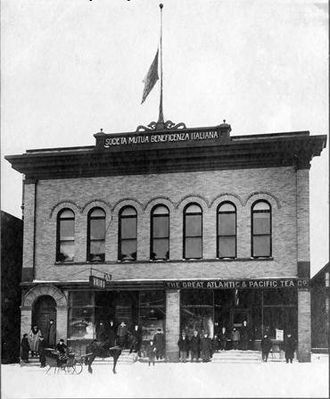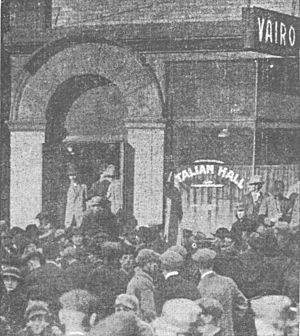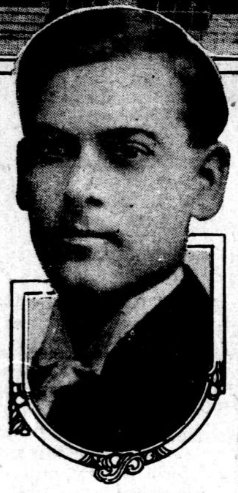Italian Hall facts for kids
Quick facts for kids Italian Hall |
|
|---|---|

Italian Hall on December 25, 1913
|
|
| General information | |
| Architectural style | Romanesque Revival |
| Location | Calumet, Michigan |
| Coordinates | 47°14′54″N 88°27′19″W / 47.2484°N 88.4554°W |
| Construction started | 1908 |
| Inaugurated | Columbus Day, 1908 |
| Demolished | October 1984 |
| Cost | $25,000 |
| Client | Società Mutua Beneficenza Italiana |
| Technical details | |
| Floor count | 2 |
| Design and construction | |
| Architect | Paul Humphrey Macneil |
| Main contractor | P. J. Donahue |
|
Formerly listed on the U.S. National Register of Historic Places
|
|
| Location | 7th and Elm Sts. |
| NRHP reference No. | 80001858 |
| Significant dates | |
| Added to NRHP | July 23, 1980 |
| Removed from NRHP | April 18, 1988 |
The Italian Hall was a two-story building in Calumet, Michigan. It was built in 1908 and taken down in 1984. Before this, two other buildings called "Italian Hall" stood in the same spot. The first floor had shops. A big hall was on the second floor.
It was the main place for the Società Mutua Beneficenza Italiana (Italian Mutual Benefit Society). Many community events happened there. The hall is famous for a sad event in 1913. More than 70 people died after someone falsely yelled "fire" during a Christmas party. Today, the site is a memorial park. It is a Michigan State Historic Site. The building was once on the National Register of Historic Places.
Contents
Building Design and Use
The Italian Hall was built in the Romanesque Revival style. It was located on Seventh Street in Calumet. The building was rectangular and faced east. Its walls were made of brick and stone.
The front of the building had seven arched windows on the second floor. A metal trim, called a cornice, was on the main wall. It said "Societa Mutua Beneficenza Italiana" in Italian. There were three chimneys on the roof. The first and second floors had metal ceilings.
When it was new, the first floor had two shop spaces. They also had storage rooms and living areas at the back. Each shop had its own entrance. In 1913, one shop was a grocery store. The other shop was a saloon owned by Dominic Vairo.
At the front of the building, a special doorway led to a foyer. From there, you could go into the saloon. Straight ahead were double doors. These doors led to a staircase that went up to the second-floor hall.
The hall itself was very large. At the back, there was a stage. Below the stage was a kitchen. A barroom was on one side. A viewing gallery overlooked the hall. The hall also had two fire escapes. The Italian Mutual Benefit Society used the hall for its activities. Other groups also rented it for meetings and events.
Later, the two storefronts were removed. A single entrance was put in the middle of the first floor. The metal trim on the roof was also taken down. One of the arched windows was boarded up.
History of Italian Hall
Early Buildings and Construction
The Italian Mutual Benefit Society started in 1875. They built their first hall in 1890. But it fell down in strong winds. In 1891, they rebuilt it. This time, it was a large wooden building. It had shops on the first floor and a hall on the second.
This wooden building burned down on January 1, 1908. Luckily, no one was hurt. All these buildings on the site were known as "Italian Hall."
The most recent Italian Hall was built in 1908. It cost $25,000. Paul Humphrey Macneil designed it. P. J. Donahue was the main builder. The building officially opened on Columbus Day, 1908.
The 1913 Disaster
In July 1913, a big workers' strike began in the copper mining area. On Christmas Eve, December 24, 1913, a party was held at Italian Hall. It was for the children of the striking miners. About 500 children and 175 parents were there.
In the late afternoon, the children were waiting for presents. Suddenly, someone yelled "fire!" There was no real fire. But everyone rushed to escape down the main staircase. People at the bottom were crushed by the crowd. More than seventy people died, most of them children.
Newspapers across the country reported on the disaster. These included The New York Times and Boston Daily Globe. No one was ever found responsible for yelling "fire." There was an investigation by the government.
A common misunderstanding is that the doors opened inward. This would have trapped people. But the doors actually opened outward, which is safer. Woody Guthrie later wrote a song about this sad event. It was called "1913 Massacre".
After the Disaster: 1914 to Today
After the 1913 disaster, Italian Hall was used for about 50 more years. By 1975, the building was empty. It was named a Michigan State Historic Site in 1977. In 1980, it was added to the National Register of Historic Places.
The building became unsafe. The cost to fix it was too high. So, Italian Hall was taken down in October 1984. A group called "Friends of the Italian Hall" saved the main doorway. They wanted to use it for a memorial.
In 1987, a historical marker was placed at the site. The building was removed from the National Register of Historic Places in 1988.
The 75th anniversary of the disaster was in 1988. This led to more action for the site. In 1989, the area became a memorial park. The saved doorway was put back up. Local union members helped build the park for free.
Today, the park has the doorway arch and historical markers. The doorway has brass plaques from people who donated to the memorial. The Michigan State Historic Site marker tells about the 1913 disaster. It also shares the building's history.
There are brick paths, benches, and a flagpole. Students from Michigan Technological University have studied the site. They want to improve the park and help people learn more about its history.
The original exterior doors from the stairway are on display. You can see them at the Coppertown USA Museum in Calumet. One of the stairway steps is also shown at the Keweenaw National Historical Park visitor center.
In 2017, work began on a new monument. It lists the names of the people who died in 1913. The monument is made of black granite. It was installed in August 2018. A special ceremony was held on December 24, 2018. This was the 105th anniversary of the disaster. The stone lists the names and ages of the 73 victims.
Images for kids








